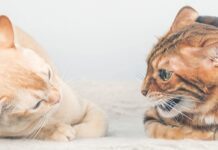Pipper loved to lick plastic and crawled eagerly into every plastic bag she could find. But the longhaired black cat’s fascination with plastic eventually progressed to a big problem — chewing the plastic and ingesting tiny pieces to the alarm of her owner, Pamela Perry, DVM, Ph.D., a lecturer in animal behavior at the Cornell University College of Veterinary Medicine.
While some dogs chew sundry objects from shoes to sofa legs, cats tend to focus on houseplants, thread, string, yarn and electrical cords. Some, though, like Pipper, chew plastic, and Dr. Perry reached a turning point with the threat to her cat’s health. Ingested plastic could lead to an intestinal blockage. “I had to make sure that all plastic bags were put away,” she says. “They had to be well-hidden or she would find a way to get them.”
Safer Alternatives. Instead, she gave Pipper a safe alternative — a strong plastic Elizabethan collar that the cat’s teeth couldn’t break. “Licking the E-collar seemed to satisfy her. It gave her an outlet for the behavior without putting her health at risk.” Dr. Perry developed other tactics to keep her cat safe as they shared a blissful life together before Pipper succumbed to cancer at 13½. Her sanity-saving advice for coping with these hazards can help anyone who lives with a relentless chewer:
Houseplants: Cats enjoy chewing them, so you face a challenge. The ASPCA Animal Poison Control Center lists 400 plants from Adam and Eve (Arum maculatum, prompting drooling, vomiting and difficulty swallowing) to Yucca (Yucca sp., which can cause vomiting and diarrhea) as being toxic to cats. “Lilies are also taboo around cats because they are highly toxic. Ingesting even a small amount of the plant can result in kidney failure within hours,” Dr. Perry says.
Safe plant options include rye or oat grass. Dr. Perry advises clients to plant grass in large, shallow containers, such as aluminum baking pans. The seeds sprout fairly quickly. If a container is big enough, some cats like to sleep atop the grassy bed. “They really seem to enjoy it,” Dr. Perry says. “It gives them a piece of the outdoors.”
More than 500 indoor and outdoor plants are listed at ASPCA.org as nontoxic to cats, including common houseplants such as Boston fern and African violets. If your cat chomps these leaves, try misting leaves with water and a sprinkling of cayenne pepper, or spray leaves with a commercial pet repellent such as bitter apple. The odor of mothballs in the soil also could ward off your pet, as advised by the Cornell Feline Health Center’s webpage on destructive behavior (http://bit.ly/catshredtip).
Electrical cords: If your cat chews electrical or phone cords, make them inaccessible. As with pieces of plastic, if a cat swallows a piece of the cords, it can cause intestinal blockages. Worse yet, if the cat chews through the cord, he can be electrocuted. Hard-plastic cord caddy organizers or automatic rewind extension cord reels can keep phone and electrical cords out of reach.
Chewing behavior in cats can be due to a number of reasons — exploration, hunger, owners’ inadvertent reinforcement or a compulsive disorder. Pipper’s habit of licking plastic started as play and exploration, but later developed into a compulsive behavior aggravated by stress, such as a visit to the veterinary clinic or delayed mealtimes.
In addition to providing free access to the plastic Elizabethan collar, Dr. Perry managed the behavior by feeding Pipper part of her meals from food-dispensing toys.
The activity gave her mental enrichment and slowed her eating, providing a bonus for the other cats. Previously, Pipper would quickly finish eating and take food from their dishes. An alternative for stimulating exploratory behavior is to hide food or treats around the house for your cat to find.
Determining the reason for excessive chewing is paramount. It’s not for spite, as some owners believe. “Animals are expressing themselves when they chew,” Dr. Perry says. “They are not doing this to get back at us, so it is important not to punish them. Instead, we need to identify the cause and deal with it appropriately.”



